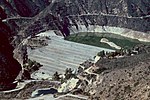East Fork Road
East Fork Road, located in the San Gabriel Mountains above the city of Azusa, California, is a road that gives access from State Route 39 into East Fork and other small townships, including Camp Williams, and Julius Klein Conservation Fire Camp 19, a minor offender prisoner housing complex where "LACO fire personnel provide training, which prepares inmates to safely conduct wild land firefighting operations."The road begins at Route 39, passing over the San Gabriel River, and follows the east fork of the river, crossing a number of small streams. The terminus is Heaton Flats, which has a campsite, a toilet facility, and trails that lead upstream and to the summit of Iron Mountain, 8,007 feet (2,441 m) above. Along East Fork Road there are extensive fire-fighting facilities which are staged to combat the many fires that break out among the foothills above Azusa, Glendora, and San Dimas every year. The road is located within the Angeles National Forest and is managed by the United States Forest Service. The United States Forest Service states that all mining operations, including gold panning, are illegal along the East Fork; however, as mining and prospecting are a historic relic of California's heritage, enforcement of the mining laws is infrequent and gold panning continues along this stretch of the road (which offers easy access to the river). Some of the sites of the area's mining heritage can be accessed from the road by visiting the site of "Eldoradoville", a mining town with three stores and six saloons that was established in 1859 and washed away in the flood of January 18, 1862.East Fork Road was initially planned as an outlet from the Los Angeles Area to State Route 2 and includes a "Bridge to Nowhere" that was abandoned after a flood; a later plan included two never-used tunnels on the aborted Shoemaker Canyon Road.In January 2005 a flood washed out two bridges, which stranded 200 campers and residents for days.
Excerpt from the Wikipedia article East Fork Road (License: CC BY-SA 3.0, Authors).East Fork Road
East Fork Road,
Geographical coordinates (GPS) Address Nearby Places Show on map
Geographical coordinates (GPS)
| Latitude | Longitude |
|---|---|
| N 34.234166666667 ° | E -117.80138888889 ° |
Address
East Fork Road 2398
91702
California, United States
Open on Google Maps









